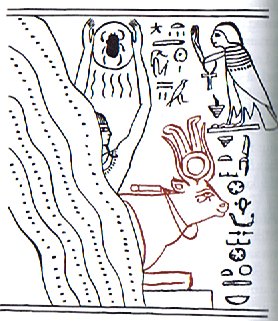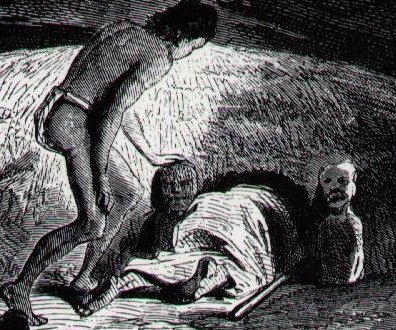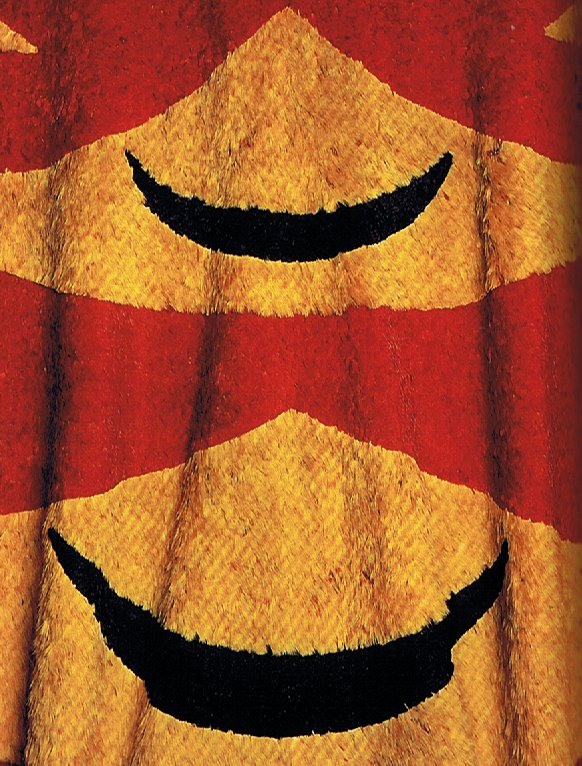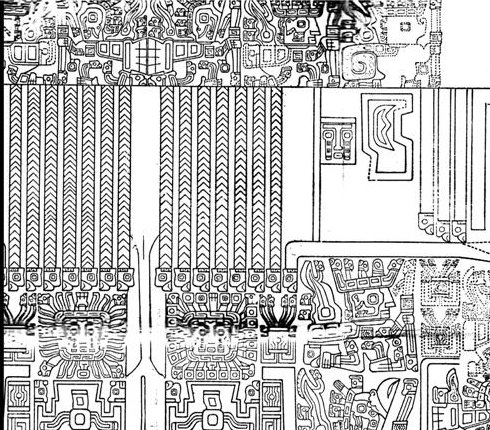Once again. The Chinese, who began their list in autumn with Spica - where the Sun was bound to go down to the fishes - had placed Ain as the star marking their station number 19, the Net: ... In the arabesque of interlaced motifs, one can mark those where the theme of 'pulling down the structure' is in evidence. The powerful Maori hero Whakatau, bent on vengeance, laid hold of the end of the rope which had passed round the posts of the house, and, rushing out, pulled it with all his strength, and straightaway the house fell down, crushing all within it, so that the whole tribe perished, and Whakatau set it on fire. This is familiar. At least one such event comes down dimly from history. It happened to the earliest meetinghouse of the Pythagorean sect, and it is set down as a sober account of the outcome of a political conflict, but the legend of Pythagoras was so artfully constructed in early times out of prefabricated materials that doubt is allowable. The essence of true myth is to masquerade behind seemingly objective and everyday details borrowed from known circumstances. However that may be, in many other stories the destruction of the building is linked with a net. Saxo's Amlethus does not pull down pillars; he reappears at the banquet set by the king for his own supposed funeral, like Great-Land-Master himself. He throws the knotted carpet net prepared by his mother over the drunken crowd and burns down the hall. In Japan the parallel does not go farther than that but it has its own relevance nevertheless. It suggests the fall of the House of Atreus. The net thrown by Clytemnestra over the king struggling in his bath cannot have come in by chance. But this is an uncertain lead as yet. The Sacred Book of the ancient Maya Quiche, the famous Popol Vuh (the Book of Counsel) tells of Zipacna, son of Vucub-Caquix (= Seven Arata). He sees 400 youths dragging a huge log that they want as a ridgepole for their house. Zipacna alone carries the tree without effort to the spot where a hole has been dug for the post to support the ridgepole. The youths, jealous and afraid, try to kill Zipacna by crushing him in the hole, but he escapes and brings down the house on their heads. They are removed to the sky, in a 'group', and the Pleiades are called after them. Then there is a true avanger-of-his-father, the Tuamotuan Tahaki, who, after long travels, arrive in the dark at the house of the goblin band who tortured his father. He conjures upon them 'the immense cold of Havaiki' (the other world) which puts them to sleep. Then Tahaki gathered up the net given to him by Kuhi, and carried it to the door of the long house. He set fire to the house. When the goblin myriads shouted out together 'Where is the door?' Tahaki called out: 'Here is it.' They thought it was one of their own band who had called out, and so they rushed headlong into the net, and Tahaki burned them up in the fire. What the net could be is known from the story of Kaulu. This adventurous hero, wanting to destroy a she-cannibal, first flew up to Makalii the great god, and asked for his nets, the Pleiades and the Hyades, into which he entangled the evil one before he burned down her house. It is clear who was the owner of the nets up there. The Pleiades are in the right hand of Orion on the Farnese Globe, and they used to be called the 'lagobolion' (hare net). The Hyades were for big game ...
... he gathered all the coconut husks of his land and rolled the fibre, and he plaited it into ropes of very great strength. But these ropes also were of no use, for the sun-god made them frizzle up. Therefore Maui took the sacred tresses of his sister Hina, he cut off lengths of Hina's hair and plaited it, to make a rope whose mana could not be destroyed by Ra. He took that noose of Hina's hair, he travelled eastward to the border of the sea; he placed his ropes around the pit from which the sun rises, waited there, he waited for the dawn. Then Ra came up, he came up from the spirit-world which lies in the east. Maui pulled the cord, he caught the sun-god by the throat! Ra struggled, kicked, he screamed against the sky. 'Then will you go more slowly if I turn you loose?' The sun then promised Maui, 'Let me go, and I will move more slowly, I will make longer days for your fishing'. Since that time, men have had longer days in which to go about their work ... Night 29 was the last night in the month, when the Moon was no longer visible, but it was also a night with promise of her return to life again around the corner, reincarnated and fresh as new: ... When the new moon appeared women assembled and bewailed those who had died since the last one, uttering the following lament: 'Alas! O moon! Thou has returned to life, but our departed beloved ones have not. Thou has bathed in the waiora a Tane, and had thy life renewed, but there is no fount to restore life to our departed ones. Alas ... Similarly the months of the Sun were finished with number 19. For instance did the Mayas have a special short 5-day month at the end of their haab year and this was month (uinal) number 19. The implications were the same as at the time of the new moon - death and regeneration. Therefore we could say either 365 = 18 * 20 + 1 * 5 or 365 = 1 * 5 + 18 * 20. ... Nut, whom the Greeks sometimes identified with Rhea, was goddess of the sky, but it was debatable if in historical times she was the object of a genuine cult. She was Geb's twin sister and, it was said, married him secretly and against the will of Ra. Angered, Ra had the couple brutally separated by Shu and afterwards decreed that Nut could not bear a child in any given month of any year. Thoth, Plutarch tells us, happily had pity on her. Playing draughts with the Moon, he won in the course of several games a seventy-second part of the Moon's light with which he composed five new days. As these five intercalated days did not belong to the official Egyptian calendar of three hundred and sixty days, Nut was thus able to give birth successively to five children: Osiris, Haroeris (Horus), Set, Isis and Nepthys ... The Chinese used the Crow as a clue for this interpretation - the Crow (Corvus) was a station after the death of the old Sun and it ought to have served the same function as the station of the Vulture up in the southwest for the ancient Egyptians.  Reading the C text we can guess the old Sun bird (manu ra) had reached her terminal point (ihe) when she reached the Scorpion. But she was pregnant. The basic type of glyph at Cb2-12 (where 2 * 12 = 24) is in principle henua, but I have found reason to make a special case for this fruitful place:
Because I had found this type of glyph at 'midnight' in the following Tahua sequence. Ehu at the beginning of the night means 'ashes':
... The low entrances of houses were guarded by images of wood or of bark cloth, representing lizards or rarely crayfish. The bark cloth images were made over frames of reed, and were called manu-uru, a name given also to kites, masks, and masked people ...
In the Easter Island cosmography as projected down onto the Land the place corresponding to the central ceremonial ground (raaraa) could have been Vinapu - where my imagination insists the name could mean uinal-pu, i.e. the 5-day hole (pu) for the birth of a new Sun (year): ... In Mexican cosmology the sky fell down as the result of a prolonged rainy spell. Two gods changed themselves into trees with which it was then supported. Rain also caused the collapse of the sky in a story told by the Kato of the northwestern United States. Naga-itcho, Great Traveler, saw that the old sky which was made of sandstone and badly cracked in places was about to fall, so he and Thunder constructed a new sky. They supported it on pillars with openings at the cardinal points for clouds, winds, and mist to pass through and laid out winter and summer trails for the Sun to follow ...
... 1. Hanga Te Pau, the landing site of Ira and his band of explorers, is the natural anchorage for those approaching Vinapu by sea. The remarkable stone fronts of the ahu of Vinapu are all facing the sea. The explorers landed at Hanga Te Pau during the month 'Maro', that is, June ... 2. The cult place of Vinapu is located between the fifth and sixth segment of the dream voyage of Hau Maka. These segments, named 'Te Kioe Uri' (inland from Vinapu) and 'Te Piringa Aniva' (near Hanga Pau Kura) flank Vinapu from both the west and the east. The decoded meaning of the names 'the dark rat' (i.e., the island king as the recipient of gifts) and 'the gathering place of the island population' (for the purpose of presenting the island king with gifts) links them with the month 'Maro', which is June. Thus the last month of the Easter Island year is twice connected with Vinapu. Also, June is the month of summer solstice [a mistake: south of the equator it is winter solstice], which again points to the possibility that the Vinapu complex was used for astronomical purposes. 3. On the 'second list of place names', Hanga Te Pau is called 'the middle (zenith) of the land' (he tini o te kainga). This may refer to a line bisecting the island, but it can just as easily mean the gathering of a great number (of islanders). The plaza (130 x 130 meters) would have been very well suited for this purpose. 4. The transformation of the 'second list of place names' into a lunar calendar links Hanga Te Pau and Rano Kau. A similar linkage occurs in connection with the third son of Hotu Matua between the 'pebbles of Hanga Te Pau' and his name 'Tuu Rano Kau'. There can be no doubt that Vinapu was dependent on the economic resources of the large crater ... In the midwinter month of Maro the poultry grew lots of warm feathers. These signs of warmth (fire) could then be given to the Island King, because he was freezing and in need of fire. It was a dark time.
However, another interpretation (than assuming winter solstice) could be to point out that immediately before the Sun king (Hotu Matua) reached Easter Island it should by cause of contrast have been an very dark time. The whole island community could therefore have been assembled in the central ceremonial plaza (raaraa = Vinapu) in the night of Tagaroa 14 (287 = 7 * 41), because this was the day before Antares (Hotu Matua) would rise heliacally. 2 * 12 = 24 = midnight could have been the precise time of his birth. And nothing of importance could be accomplished unless everyone took part: ... When it was evident that the years lay ready to burst into life, everyone took hold of them, so that once more would start forth - once again - another (period of) fifty-two years. Then (the two cycles) might proceed to reach one hundred and four years. It was called 'One Age' when twice they had made the round, when twice the times of binding the years had come together. Behold what was done when the years were bound - when was reached the time when they were to draw the new fire, when now its count was accomplished. First they put out fires everywhere in the country round. And the statues, hewn in either wood or stone, kept in each man's home and regarded as gods, were all cast into the water. Also (were) these (cast away) - the pestles and the (three) hearth stones (upon which the cooking pots rested); and everywhere there was much sweeping - there was sweeping very clear. Rubbish was thrown out; none lay in any of the houses ... 288 ("October 15) = 2 * 144 = 24 * 12 (as if alluding to Christmas Eve). And from "May 24 (144) to 288 ("October 15) there were 144 days:
The fish-hook in Ga2-11 was probably drawn to be at Nunki (where Land was ending), but also at the position of ║June 30 in the Gregorian calendar (where the Sun would rise with Sirius, the brightest star in the night). And now we can see that it was also where in rongorongo times there were 12 * 12 days to Antares. ... This [σ] has been identified with Nunki of the Euphratean Tablet of the Thirty Stars, the Star of the Proclamation of the Sea, this Sea being the quarter occupied by Aquarius, Capricornus, Delphinus, Pisces, and Pisces Australis. It is the same space in the sky that Aratos designated as Water ... ... The Sothic cycle was based on what is referred to in technical jargon as 'the periodic return of the heliacal rising of Sirius', which is the first appearance of this star after a seasonal absence, rising at dawn just ahead of the sun in the eastern portion of the sky. In the case of Sirius the interval between one such rising and the next amounts to exactly 365.25 days - a mathematically harmonious figure, uncomplicated by further decimal points, which is just twelve minutes longer than the duration of the solar year ... In the glyph Ga7-15 (184) I have always perceived the 6 'stones' of the Pleiades. The old Pleiades (half) year was ending at the birth of the new Antares (half) year. *184 (SEPTEMBER 21) = 72 (MARCH 13, when Alcyone rose with the Sun) - 80 + 384 / 2. Alcyone was the Foundation Stone (Temennu) of the ancient Babylonians, their 3rd station of spring.
But for the ancient Chinese Alcyone marked their 18th station of autumn, the Hairy Head. And the hairy tresses at the back side of Pachamama may have illustrated the 400 'youths dragging a huge log' for the ridgepole of their house.
In Ga7-19 we can see how the Fire is bursting forth into flames again, south of the equator. 64 precessional days earlier Antares would have risen with the Sun in SEPTEMBER 22 (265) = the autumn equinox. However, the Julian calendar had 'March 25 (84) as the day for the northern spring equinox and 84 + 184 = 268 (SEPTEMBER 25). ... When Julius Caesar established his calendar in 45 BC he set March 25 as the spring equinox ... The fish-hook in Ga2-11 probably corresponded to MAY 1 (121):
 136 - 121 = 15 = the precessional distance up from Alcyone (*56) to Bharani (*41). I.e. they were the same, they both gave birth to the morning Sun, which the round (implying a vertical mill shaft) Dendera roof explained.  |
||||||||||||||||||||||||||||||||||||||||||||||||||||||||||||||||||||||||||||||||||||||||||||||||||||||||||||||||||||||||||||||||||||||||||||||||||||||||||||||||||||||||||||||||||||||||||||||||||||||||||||||||||||||||||||||||||||||||||||||||||||||||||||||||||||||||||||||||||||||||||||||||||||||||||||||||||||||||||||||||||||||||||||||||||||||||||||||||||||||||||||||||||||||||||||||||
















